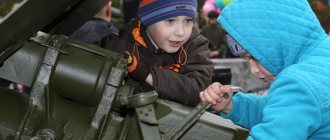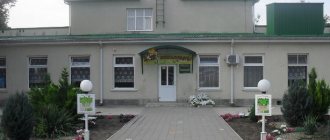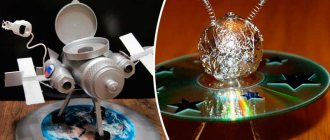MAGAZINE Preschooler.RF
Article “The concept of work to introduce children to their native land”Pedagogical concept of the teacher of the first qualification category of MADOU "Kindergarten No. 29 of a combined type" of Petropavlovsk-Kamchatsky Oksana Vladimirovna Polishchuk on the topic: "Organization of local history work with preschoolers .
Justification of the relevance and prospects of the experience. Its importance for improving the educational process.
Homeland. Fatherland. Fatherland. Father's land. This is what people call the land on which they were born, and there is nothing dearer to a person than the Motherland, the beauty of which was once revealed to him as a miracle. We adults need to help the child discover this miracle, introducing him to nature and everyday life, history, and culture of his native land. Getting acquainted with his small Motherland, the child begins to love her and retains a feeling of attachment to her for life.
The relevance of studying local history in modern society is obvious. Local history is one of the most important sources of expanding knowledge about the native land, nurturing love for it, and developing citizenship.
In preschool age, the formation of a person’s character, thinking, and speech occurs, and a long process of forming moral values begins, which underlie love for the Motherland. The love for the homeland of the younger generation begins with a feeling of their native land, their native land. That is why local history work should be carried out already from kindergarten - from the age when the process of socialization and personality formation begins.
In my opinion, a child’s feeling as a patriot should begin with the awareness of himself as a part of his small homeland. Material on local history is a rich source that makes it possible to fill the gaps in the moral education of children that have arisen recently.
The study of local history fosters the desire to be useful to one’s hometown, the place where one was born and raised, and becomes the foundation on which one can cultivate pride in one’s country, one’s region and the desire to actively participate in social processes. Local history work broadens children's horizons and develops children's verbal and visual creativity.
I would like to recall the wonderful words of the famous Russian scientist D.S. Likhacheva: “Local history teaches people not only to love their native places, but also to know about them, teaches them to be interested in history, art, literature, and to improve their cultural level. This is the most popular form of science .
Conditions for the formation of the leading idea of experience, conditions for the emergence and formation of experience.
Introducing preschoolers to the cultural and natural origins of their small Motherland is now becoming one of the priorities.
During childhood, the basic qualities of a person are formed. It is especially important to imbue the child’s receptive soul with sublime human values and to arouse interest in his small Motherland.
I pay special attention to the development of love for their native land, cognitive abilities and needs by introducing children to the flora and fauna, forming children’s interest in folk art, and providing conditions for raising children in the spirit of tolerance.
We all know the proverbs “Great is the world, but there is no warmer land than your own” , “A home is more valuable than gold” , “In your own land the water is sweeter” - these wise words, which have become proverbs and sayings, do not require proof. They were the moral standard, the way of life of our ancestors
What do these words mean for our children? I addressed this question to my students. The answers I received (this is interesting; it’s important to know this in order to respect the history of your ancestors; it’s always interesting where you come from; without knowing the history of your native land you cannot consider yourself a cultured person), allowed me to conclude: the guys are interested in this.
Local history today is becoming an important means of improving the quality of knowledge. Using local history material in the classroom, I noticed that it activates children’s mental activity, allows them to diversify the teaching methods, and participates in the patriotic education of preschoolers.
The main goal of my work in local history is: to form a child’s knowledge about the natural world of his native land, to form realistic knowledge about its objects and phenomena, to teach him to observe, notice, reflect and reason. Actively communicate with nature, acquiring new knowledge, skills and abilities. To introduce the social life of Kamchatka, the life and culture of the peoples inhabiting it, history, literary heritage, symbols.
The following tasks are aimed at achieving this goal:
- Expand the horizons of pupils with new knowledge about the Kamchatka region.
- Foster an emotionally positive attitude towards nature, develop the ability to see and understand its beauty;
- To cultivate a caring attitude towards the animal world, a sense of empathy and belonging to nature.
- Show children the importance of animal biodiversity for humans.
I believe that solving the problems of familiarizing preschoolers with their native land will be facilitated by:
- creation in the group of an expanded center for local history with various didactic and gaming aids;
- early start of education for preschoolers;
- inclusion of elements of local history in all types of children’s activities.
The development of work on local history should not be carried out periodically, but systematically and step by step.
The development of work on local history is a task on a federal scale, important for the whole of Russia and for any corner of our Motherland. It is most effective if organized as a holistic system. I study local history not only in class, but also in my free time.
Thus, the organization of local history activities is the introduction of a little person into the world of his small homeland.
Technology of experience. System of specific pedagogical actions, content, methods, techniques of education and training
Kamchatka nature is full of charm not only in itself.
Introducing the children to the Kamchatka region, I talked about what it is famous for: Volcanoes, nature reserves, extraordinary nature, animals. I pay a lot of attention to getting to know the Kronotsky Nature Reserve.
I made a plan for introducing children to the Kamchatka Territory, and a plan for introducing them to the Kronotsky Nature Reserve. I have selected a lot of literature and didactic material to familiarize children with the Kamchatka region.
The leading form of work to get acquainted with the native land is classes on cognitive development.
Of no small importance in the development of children's activity is a well-equipped, rich subject-development environment, which stimulates the child's independent activity and creates optimal conditions for intensifying the course of self-development. In this regard, in the group, I created a center for local history, where conditions were created for joint and independent activities of children. The center has a variety of material: thematic albums about Kamchatka, about the city of Petropavlovsk-Kamchatsky, about the villages of the Kamchatka Territory, photographs of attractions, material on the Nature Reserves of the Kamchatka Territory.
The center has a variety of equipment. A competent combination of materials and equipment in the corner helps expand the cognitive, communicative, artistic and aesthetic experience of children.
A special place in local history work is occupied by the didactic means of museum pedagogy, which help to recreate in the minds of children pictures of the past of our region, to introduce household items, tools, and clothing of our ancestors. Natural history exhibitions show the richness and diversity of the flora and fauna of Kamchatka.
An important method of presenting information to children, especially of a historical nature, is an educational story. Considering that preschoolers are characterized by visual-figurative thinking, it is necessary to accompany it with visual material: photographs, illustrations, slides, diagrams, as well as ancient household items.
Presentations were selected and developed for each lesson to familiarize children with their native land and the Kronotsky Nature Reserve:
Presentations about the Kamchatka region:
- Volcanoes of Kamchatka.
- City `s history.
- World of Kamchatka Wildlife.
- Peoples of the North.
- Our town.
- Lakes of Kamchatka.
- Monuments of Kamchatka
- Kamchatka fashion, etc.
- Animals of Kamchatka.
Presentations about the Kronotsky Nature Reserve:
- History of the Kronotsky Nature Reserve.
- Who works in the reserve.
- Valley of Geysers.
- Death Valley.
- Volcanoes of the Kronotsky Nature Reserve.
- Volcano Uzon.
- Brown bears.
- Wild reindeer.
- Kronotskoye Lake.
- Marine mammals.
- Fir grove.
- Plants of the Kronotsky Nature Reserve, etc.
Films about the Kronotsky Nature Reserve and the Kamchatka Territory were also selected.
Taking into account the leading activities of children, I widely use various types of games in local history work. She has developed a number of didactic games to get acquainted with the Kamchatka region ( “Where I am” , “Find out and tell” , “When it was” ), the nature of the Kamchatka land ( “Ecological traffic light” , “Who lives in the forest”, “Edible - inedible” and etc.), the labor of fellow countrymen ( “Who worked?” , “What is Kamchatka land rich with?” ).
The work of introducing the enterprises of the region and the work of fellow countrymen develops into an interesting long-term role-playing game in which children apply their knowledge and already accumulated life experience ( "Sailors" , "Fishermen" , "Tour Guide" , "Construction" , etc.)
One of the forms of working with children is productive creative activity, which includes drawing, appliqué, and manual labor. It allows you to consolidate the acquired knowledge of children and reflect the emerging attitude towards the subject being studied. I present the results of children’s productive activities in the form of thematic exhibitions.
Positive emotions play a significant role in the formation of moral and patriotic feelings in preschool children. A national holiday, a local history quiz, a thematic entertainment (about work, native nature) is the logical and emotional conclusion of the work on each of the developed topics.
I held such events as “Hololo Holiday” , quiz “Love and Know the Kamchatka Territory” , “Kamchatka Folk Tales” , “Traditions of the Indigenous Population” .
During my work with children, we visited the Kamchatka Museum of Local History and the Kamchatka Exhibition Center, the Kamchatka Museum of Military Glory , where the children were introduced to the social life of Kamchatka, the life and culture of the peoples of Kamchatka, and the history of Kamchatka.
I work closely with the Kronotsky Nature Reserve. In the preparatory group, guests came from the Kronotsky Reserve and had a wonderful lesson about the salmon of the Kronotsky Reserve and the bears of the Kronotsky Reserve.
An important condition in solving problems in local history work with preschoolers is a close relationship with the families of the pupils. In my work, I rely on parents not only as helpers, but as equal participants in the formation of the child’s personality. Parents also participate in creating a developmental environment: organizing local history photo exhibitions, decorating folklore holidays, organizing exhibitions of folk applied art.
Performance Analysis
The effectiveness of pedagogical experience is that local history awakens interest in the culture of the native land. I believe that children develop:
- the correctness and completeness of ideas about the native land, about one’s nationality, about the traditions of the native land;
- understanding and respect of other peoples and cultures;
- interest in the traditions of the indigenous population;
- awareness of the need for mutual understanding between people and nations.
| Next > |
“Methodology for introducing older preschoolers to local history”
Methodology for introducing older preschoolers to local history

One of the main tasks of educating preschoolers facing the teacher at the present stage is to instill in preschoolers a love for the Motherland, their native land, and a sense of pride in their Motherland.
The idea of the Motherland begins in children with a picture, the music the child hears, the nature around him, the life of familiar streets.
Year after year it expands, enriches, and improves. The use of local local history material in the educational process is of great importance for the formation, expansion and deepening of ideas about the native land, patriotic feelings, and instilling love for the native land. It is useful to introduce preschoolers to the successes of their native land, since local history information is closer and more understandable to them and arouses their cognitive interest.
Back in the century before last, an outstanding figure in the field of preschool education A.S. Simonovich, the organizer of the first kindergarten in Russia, attached great importance to local history. In her book she wrote: “Local history proper begins in kindergarten. This is a series of systematic conversations, observations, walks, previously well thought out by the teacher, which lead to a conscious acquaintance with the homeland and prepare the child for further understanding of living and inanimate nature, as well as geography, ecology, etc. Local history should not be understood as if it simply introduces child with the environment. What is local history?
Local history is a body of knowledge about the history, economy, nature, life, and culture of a particular region. This is the legacy left to us by our ancestors. This is a living legend and grandmother's stories, the customs of the native land and the wealth of mineral resources, fields, forests, labor achievements and military accomplishments of fathers and grandfathers. This is the experience of economic development of the region and its age-old culture. This is the very inheritance that we must not only use for its intended purpose in life, but also protect, develop and distribute among descendants.
The ability to see nature is the first condition for cultivating a worldview of unity with it, the first condition for cultivating love for one’s native land through nature. It is achieved only through constant communication with the surrounding nature. In order to feel part of the whole, a person must not occasionally, but constantly be in a relationship with this whole. That is why the harmony of pedagogical influences requires constant communication with nature.
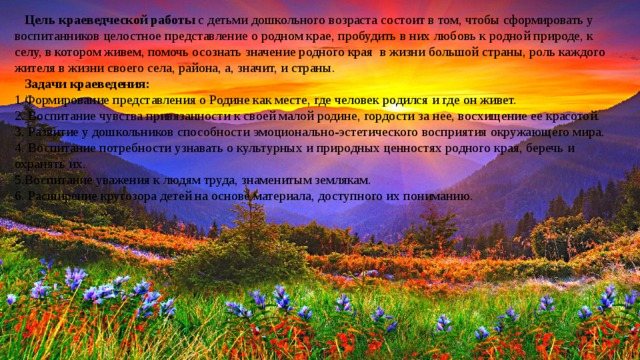
The purpose of local history work
with preschool children is to form in pupils a holistic idea of their native land, to awaken in them a love for their native nature, for the village in which we live, to help them understand the importance of their native land in the life of a big country, the role of each resident in the life of their village , region, and, therefore, the country.
Objectives of local history:
1. Formation of an idea of the Motherland as the place where a person was born and where he lives.
2. Cultivating a sense of affection for one’s small homeland, pride in it, admiration for its beauty.
3. Development in preschoolers of the ability to emotionally and aesthetically perceive the world around them.
4. Fostering the need to learn about the cultural and natural values of the native land, to cherish and protect them.
5. Fostering respect for working people and famous fellow countrymen.
6. Expanding children's horizons based on material accessible to their understanding.
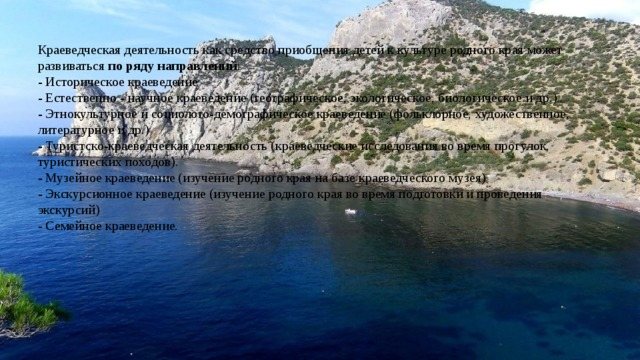
Local history activities as a means of introducing children to the culture of their native land can be developed in a number of directions
:
— Historical local history
- Naturally - scientific local history (geographical, environmental, biological, etc.).
— Ethnocultural and sociological-demographic local history (folklore, artistic, literary, etc.)
— Tourist and local history activities (local history research during walks, hiking trips).
— Museum local history (study of the native land on the basis of the local history museum)
— Excursion local history (studying the native land during preparation and conduct of excursions)
— Family local history.
The work of introducing preschoolers to the history of their hometown and its sights must be structured in such a way that it is interesting, intelligible, understandable, and emotional for children, starting with what surrounds children, what they can directly observe, gradually expanding the range of their knowledge.
Forms and methods of work in the field of local history are varied
:
This is a joint directly organized educational activity
, including different types of activities based on a single content;
Conversations
which are used as a verbal method in the classroom and as an independent form of working with children on various topics;
Excursions
, ensuring that children are introduced to the social and cultural diversity of their native village.
Holidays, entertainment
— where children get acquainted with the culture and traditions of the people inhabiting their native land.
Walks, travel, hikes
— these forms are indispensable in local history work. Cultivating love for one’s native land is impossible without communicating with nature and immersing oneself in its world.
A significant method in the work is the project method
. Local history projects allow not only to form ideas about the small and large Motherland, but also contribute to the development of independent thinking, determination, perseverance, creativity, help the child to develop confidence in their own abilities, and most importantly, develop the ability to interact with peers and adults.
Local history games occupy a special place
, which provide an opportunity to introduce a child to history, archeology, geography, and nature. For example:
"Find the coat of arms"
.
Goal: to teach to recognize the coat of arms of a village (district, district); develop fine motor skills, attention, memory; cultivate a sense of pride for your small homeland.
Progress of the game: The child is asked to find the coat of arms and tell what it means.
"Collect a coat of arms, a flag"
.
Goal: consolidate knowledge about symbolism; develop fine motor skills;
How to play: Offer to collect a picture. Tell us about the symbol you created.
"Guess the national costume"
.
Goal: To introduce children to the knowledge of the national costume and national costumes of the peoples of their native land. To consolidate knowledge about the features of the costume and its elements. Teach children to find similarities and differences.
Progress of the game: Cards with images of people in national costumes are laid out in front of the child. Among all those offered, the child must choose the named national costume. After the child has guessed the national costume, you can ask him a few questions: how did you recognize the national costume? What similarities and differences are there between the costumes?
"Red Light".
Goal: to consolidate knowledge about the plants and animals of the native land listed in the Red Book.
Progress of the game: Children choose plants and animals that are in danger from the entire flora and fauna, and tell about them.
"Do you know?"
.
Goal: introduce children to famous people of their native land.
Progress of the game: The teacher shows portraits of famous compatriots, invites the children to name the one depicted in the portrait and tell what he is famous for.
Practice shows that spatial local history concepts in preschoolers are formed faster than temporal ones. Therefore, it is necessary to organize an appropriate subject-spatial environment, the so-called local history centers
, where children could, with daily free access, expand their knowledge about their native land. Work at the local history center develops speech, thinking, and imagination in preschoolers, broadens their horizons, promotes the moral development of personality, expands the area of social and moral orientations and feelings of children, awakening love for their native village, region, and country.
The organization of local history centers (corners) in age groups makes it possible to improve the quality of work with children in the field of familiarization with the history and traditions of their native land. The content of materials in local history centers depends on the age of the children.
The purpose of creating local history centers is
a comprehensive study of his native land, Russia.
As tasks
the following can be determined:
- teach the child to understand that both people and things have their own history;
- awaken in children a feeling of love for their land, respect for its traditions and customs;
- cultivate respect for the culture of other peoples;
- to form the unity of aesthetic feelings and moral values;
- awaken emotional responsiveness in children through exposure to art, music, literature, and folk culture;
- develop the need for independent exploration of the surrounding world by studying the cultural heritage of different eras and peoples.
Thanks to the materials presented in the centers, children develop interest and respect for family, people’s work, and the labor and civic exploits of famous people of the city. Properly designed local history centers in kindergartens will make it possible to attract children’s attention to studying their region, provide an opportunity to select material based on the children’s interests, and establish joint work between teachers and children and their parents.
Recently, such an element as a mini-museum
. As part of patriotic education, a mini-museum is a necessary part of the development environment. The purpose of the created mini-museums of local history in preschool educational institutions is to involve children in activities and communication, and to influence their emotional sphere. Working with a mini-museum contributes to the cultivation of love for the small Motherland and Fatherland, the development of cognitive interest, aesthetic feelings, speech, labor, visual skills, and creative abilities.
Only purposeful and systematic work in this direction helps to cultivate feelings of patriotism in children.
Homeland. Fatherland. Fatherland. Father's land. This is what people call the land on which they were born, and there is nothing dearer to a person than the Motherland, the beauty of which was once revealed to him as a miracle. We adults need to help the child discover this miracle, introducing him to nature and everyday life, history, and culture of his native land.
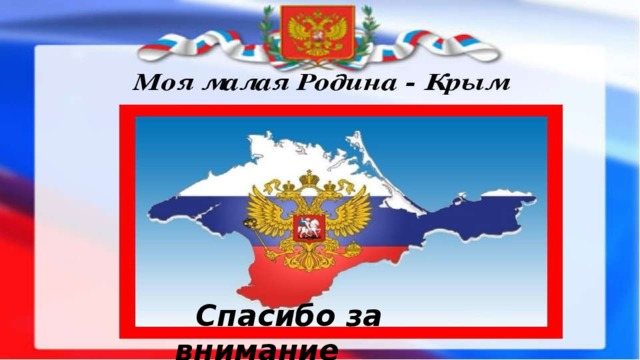
Thank you for your attention
